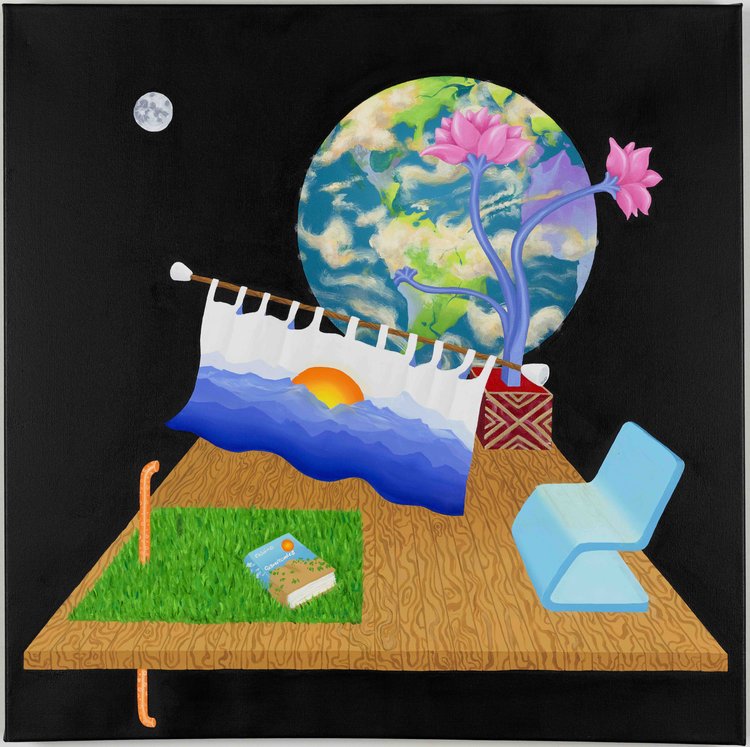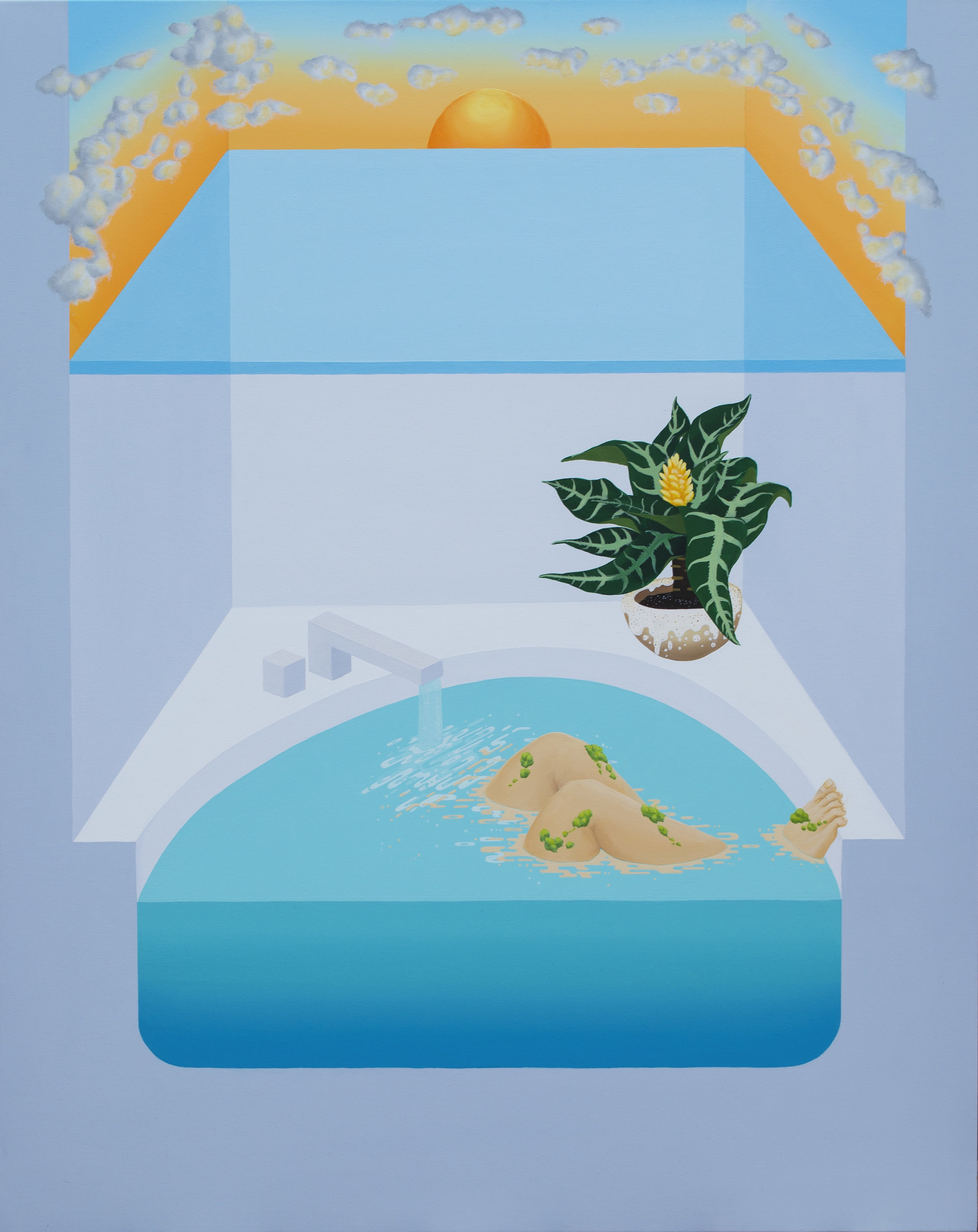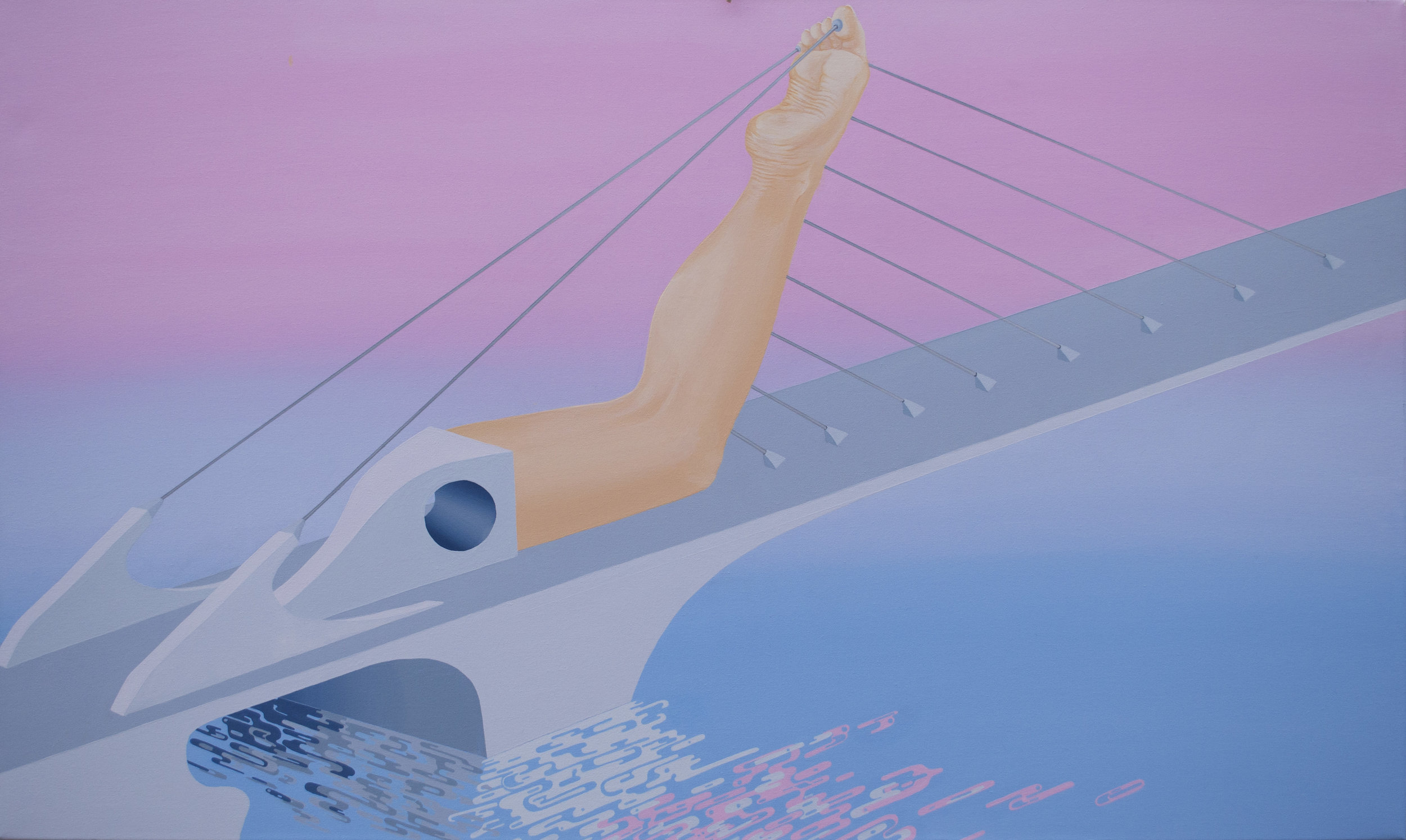Architectural body
2015-2016
Moonrise bath (2016)
50”x40”
Acrylic on canvas
Private collection
Sunset bath (2016)
50”x40”
Acrylic on canvas
Private collection
Palm trees (2015)
40”x50”
Acrylic on canvas
Private collection
Inside modern home (2016)
40”x50”
Acrylic on canvas
Leg/Bridge (다리) (2016)
30”x40”
Acrylic on canvas
Private collection
Hand place (2016)
40”x30”
Acrylic on canvas
Private collection
A thesis on overcoming personal consciousness through collective imagination
Now it is time that gods emerge
from things by which we dwell…
--Rainer Maria Rilke
These paintings are about nothing. I only meant them to make you reflect as I have reflected during making of them.
I believe that paintings do not have representative functions unless they are illustration, propaganda, or advertisement. To be representative means that there are messages to communicate to the audience, messages constructed within an intricate system of symbolism.
By definition, symbols are things made of external world that represent something else, something abstract (e.g., “green light at the end of Daisy’s dock”). So, to claim that paintings have representative functions indicates that they originate from the external world filtered through the lens of the creator who imposes some meaning in the shell of the object. Therefore, the creator controls the audience’s reaction with carefully curated set of signs and symbols[1] residing in these objects (so, the green light is not just a light, but it reflects the feeling of jealousy and envy).
In the essays critical and clinical[2], Deleuze defines art “… as an impersonal process in which the work is composed somewhat like a cairn, with stones carried in by different voyagers and beings in becoming (rather than ghosts) that may or may not depend on a single author.” In this definition, art is a collective process, with no single force in control.
I think search for symbolism in surreal painting is particularly prevalent because surreal art often mimics the familiar objects in the physical world that audience can imbue with meanings. Audience searches for signs and symbols to make sense of the new world presented by the artist, a foreign entity with different consciousness. This is totally fine. Audience has every right to make the experience of observing a painting their own. The problem is assuming that all audience will witness the same meaning, which is the meaning, endowed by the creator. This is contrary to the definition of art as a collective process. This is hierarchical and less rhyzomic, a view that consciousness is like heterogeneous and connected, ceaselessly multiplying structure with no beginning or end[3].
These paintings contain representative images, like windows, legs, bridges, etc, but not as symbols. This is because imagination comes from consciousness within, fueled by the perceptions of the external world. In Poetics of space[4], Bachelard states on miniature that their: “…Representation is dominated by Imagination. Representation becomes nothing but a body of expression with which to communicate our own images to others.”
I hope that my imagination and the audience’s imagination can overcome the representations in my paintings. As a result, when my imagination and the audience’s imagination mingle during the perception of my paintings, we achieved in sharing our consciousness. But, is individual consciousness unique and personal? Can we share our consciousness?
In a recent BBC John Peel lecture series, on ecology of culture[5] Brian Eno points out the unique ability of humans to imagine with an extraordinary complexity, unknown to other organisms. In fact, this ability to imagine is responsible for the human civilization and all the infrastructure and institutions, and whatever humans could imagine in it. It is important to recognize that art plays a vital role of fostering human’s ability to imagine, (imagine the endless stairs and melting clocks). Robert Irwin says it most concisely, “Art is a practice for the social innovation of previously unrecognized ideas or constructs[6].”
This ability to imagine allows us to empathize with other beings. In this lecture, Eno evaluates the art’s function to expand our empathy. Through art, we can imagine experiencing the feelings we have not had before. This is particularly true with works of fiction, and Eno uses Charles Dickens as an example. Dickens wrote about debtor’s prison, the poorest people in London, and Dickens’ readers, who were often aristocrats, understood that a class of people, whom they have had very little interaction with, had the same kinds of feelings the readers had. These readers, by finding this kind of connection, were able to develop a kind of empathy for the people portrayed by Dickens. Another example is writers like Neil Stephenson (Snow Crash) or William Gibson (Neuromancer) who writes of the world that never exited (yet!), really challenging the reader to imagine intensely and expansively.
Therefore, art fosters our ability to imagine and share our feelings and empathize with others. In other words, art creates spaces and experiences where we can share individual consciousness.
So, I created paintings where I can ponder with the audience and figure out how architecture came to organize around humans or how humans came to organize around architecture, and their implications. The title comes from Madeline Gin and Arakawa’s[7] book that explores and contemplates the architectural solutions to the dilemma of mortality.
The dilemma of mortality comes from the assumption that consciousness is personal, that when our bodies expire, we cease to be conscious; we cease to exist: the ultimate existential crisis. This assumption rises from the self-awareness that doesn’t seem to extend beyond our individual physical bodies. Apparently, Wittgenstein thought so too, concluding from his investigation of mind through an experiment of “beetle in a box[8].” He conjectured that one cannot feel another person’s pain, but can only infer from their own pain they had experienced before. However, if you ask a person with an alien hand syndrome, when their hand is prodded with a stick, whose pain they feel, this person would respond that it is somebody else’s pain, distinctly not their own. So, if consciousness is truly personal, how can anyone feel somebody else’s pain that is not inferred from their own?
Inversely, if consciousness is not personal, what happens when our bodies expire? Maybe this is a poorly posed problem. Is consciousness collective, and is the experience of being conscious a manifestation of a slice of the universal, collective consciousness that we have access to? Then, the dilemma of mortality may be resolved by gaining access to this universal consciousness that allows us to understand that we do not cease to exist when our bodies expire.
Architectural solutions pondered in this book and their thesis of “reversible destiny” must be the act of removing the physical and emotional constraints imposed by our surroundings, a constraint that only allows an access to a small slice of the universal consciousness. This act subsequently allows us to tap into collective consciousness and reverse our destiny where we no longer age toward non-existence. But before we can tap into this larger consciousness, we must know our surroundings and understand how they make us feel; furthermore, how they make others feel. We must know if our surrounding is somehow preventing us from tapping into this larger consciousness.
On understanding habitability and consciousness, Robert Irwin writes,
Design was the appendage of the objective logic to art and acted to replace sensate consciousness in the cultural application of technology. With the resulting lie that you can replace subjective consciousness with a system of aesthetics. This is attested to by our present humanist starved environment. Symbols of life quality have replaced subjectively felt qualities.
In other words, we may be starved of subjective consciousness because of our habitation that constrains us. Wittgenstein said, “Architecture is a gesture.” Also, Heidegger on “Building Dwelling Thinking” asserts that thinking about building and dwelling appears to advance thoughts on our conscious being[9]. Thus, through an understanding of how we respond to our environment, in this case human environment created through architecture, we can begin to expand our awareness beyond our personal experience.
These paintings explore our relationship with architecture as a way to expose the non-personal, collective consciousness concealed by our mortal habitation. The audience is physically external to these architectural artifacts while the body parts are integrated in them. Thus, the audience can make clinical observations of feelings of restrain and dependence, anxiousness and relaxation, and desperation and liberation. Consequently, we can begin to imagine what it feels as a body alien to our own that could foster a greater comprehension of our collective consciousness.
[1] “Signs and symbols” not “symbols and signs,” referencing Nabokov who considered it a waste of time to look for such devices in his works.
[2] Deleuze, Gilles. Essays Critical And Clinical. 1 edition. Minneapolis: Univ Of Minnesota Press, 1997. Print.
[3] Deleuze, G., Guattari, F., 1987. A Thousand Plateaus: Capitalism and Schizophrenia, 1St Edition edition. ed. University of Minnesota Press, Minneapolis.
[4] Bachelard, Gaston, and John R. Stilgoe. The Poetics of Space. Trans. Maria Jolas. Reprint edition. Boston: Beacon Press, 1994. Print.
[5] “2015 with Brian Eno, The John Peel Lecture - BBC Radio 6 Music.” BBC. N.p., n.d. Web. 4 Aug. 2016.
[6] Irwin, R., Simms, M., 2011. Notes Toward a Conditional Art. Getty Publications.
[7] Gins, Madeline, and Shusaku Arakawa. Architectural Body. University of Alabama Press, 2002. Print.
[8] Wittgenstein, L., 2010. Philosophical Investigations. John Wiley & Sons.
[9] Heidegger, M., 2008. Basic Writings, Revised, Expanded ed. edition. ed. Harper Perennial Modern Classics, New York.






